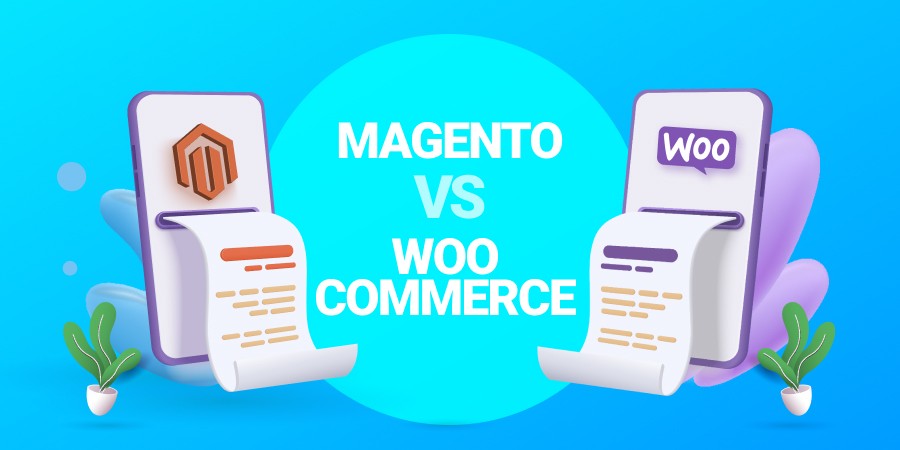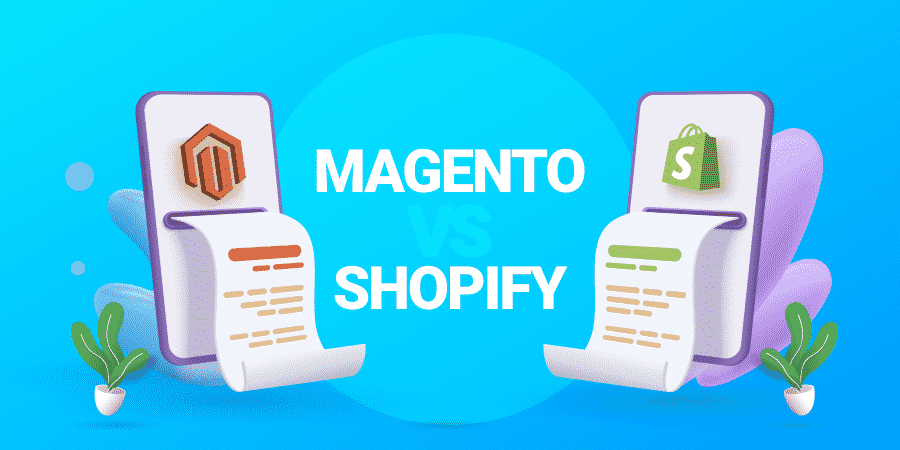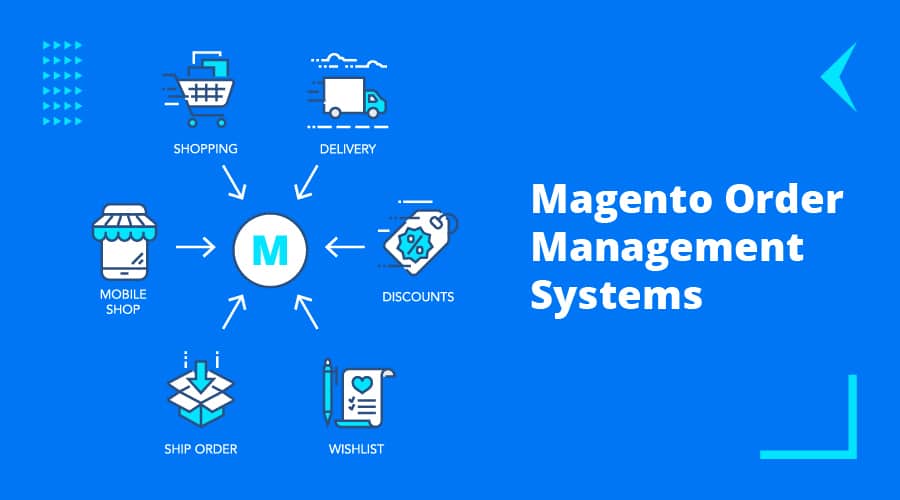Trying to decide on an eCommerce platform?
We’ve done the research and we’re sharing our insights with a Magento vs. WooCommerce platform showdown!
We’ll break down the strengths and weaknesses of each and help you decide which platform is right for your business.
Digital Silk builds custom e-stores. Request a quote
Magento (Adobe Commerce) At A Glance
Magento, now Adobe Commerce, is the most advanced eCommerce platform on the market.
It is mainly used by large-scale businesses that require highly-customized e-stores and brands that can afford a team of web developers who have advanced knowledge of coding.
Some interesting facts about Magento include:
- Magento is downloaded nearly 5,000 times every day
- Almost 7,500 retailers have migrated to Magento from other platforms
Magento Selling Points
- Ideal for large and medium-sized businesses: Magento is an advanced eCommerce platform that’s suitable for businesses that have an in-house web development team or who have the budget to hire web developers
- Large user community: With over 300,000 members, the Magento Forum has answers to any question you could think of
Magento Weaknesses
- Requires coding knowledge: Magento uses web developer jargon so you’ll need to understand and know how to code in order to use the platform
- Customer support is hard to find: Magento doesn’t have a support email or live chat support, but owners can still contact for help by calling
Popular Magento Websites
Wondering what brands are opting for Magento? Here are a few you may have heard of:



WooCommerce At A Glance
WooCommerce is an open-source eCommerce solution.
Did you notice how we used the word “solution” and not the word “platform”?
This is because WooCommerce is not its own entity. It’s a free plugin powered and engineered by WordPress.
Its popularity mainly stems from the established user-base of WordPress.
Here are some interesting stats to note about WooCommerce:
- WooCommerce is used by 4.9% of all websites
- It powers over 28.19% of all online stores
- 22% of the top 1 million eCommerce sites use WooCommerce
Our experts can help. Schedule A Consultation
WooCommerce Selling Points
- Ease of use and familiarity: WooCommerce is a free eCommerce option for WordPress lovers. The plugin’s success is predicated on WordPress’ brand name and clientele.
- Built-in support for payment processing: WooCommerce supports different payment gateways and offers built-in support for Stripe and PayPal
WooCommerce Weaknesses
- Needs a plug-in to support multiple languages: Unlike Magento, WooCommerce needs a third-party plug-in to build different store views in languages other than English
Popular WooCommerce Websites
Many brands opt for WooCommerce based on their love and familiarity with WordPress.
Here are a few you may have heard of:



Magento vs. WooCommerce: How They Compare Across 9 Key Categories
Magento vs. WooCommerce Pricing
Magento comes in three editions:
- Magento Open Source – free to install but you need to pay for hosting
- Magento Commerce – starts at $22,000 per year
- Magento Commerce Cloud – starts at $40,000 (includes hosting)
Pricing is one of the most favorable attributes of WooCommerce, as it is free to install.
Although free to install, you’ll need to invest in paid extensions and plugins to build a competitive e-shop.
The prices for these plugins can vary, depending on what you want.
For example, it costs $69 for a WooCommerce PDF Invoice & Packing Slip plugin.
Magento vs. WooCommerce Payment Gateways & Fees
Magento integrates PayPal, Stripe, Braintree, and Authorize.Net and Amazon Pay as its payment gateways.
- Magento Open Source – 2.9% + $0.30 per transaction
- Magento Commerce – 2.9% + $0.30 per transaction
- Magento Commerce Cloud – 2.9% + $0.30 per transaction
On the other hand, WooCommerce integrates Stripe, PayPal Pro, Square, Authorize.net, Amazon Pay, Apple Pay and Alibaba as its payment gateways.
Most of these payment gateways have a 2.9% + 0.30 transaction fee, while Square is a more affordable option with 2.65% + $0.30 per transaction. Apple Pay and Alibaba are also free to use.
Our verdict: WooCommerce takes this round because of their more affordable transaction fees.

Magento vs. WooCommerce Design Features
Without a doubt, Magento is known for its highly customizable themes.
In fact, when designing for Magento, you can create your very own them from scratch. While the level of coding complexity calls for the need to hire professionals, the end result pays off with an e-store that is truly unique.
While there are thousands of pre-made themes available for your WooCommerce e-store, the closest option you have to customization is to modify sections using a page builder.
Our verdict: While it’s definitely easier and more affordable to choose a pre-made theme, nothing beats a customized theme that you can design to perfectly represent your brand.

Magento vs. WooCommerce Ease-of-use
While we don’t want to burst your bubble, Magento will likely be significantly challenging for you to use if you’re not an experienced coder.
In fact, you might need to hire a team of web developers to bring your e-store to life.
WooCommerce is extremely easy to use and to navigate as a plugin because unlike Magento, you don’t need to have coding knowledge to set up your WooCommerce website.
The user experience is smooth for the initial setup and it only becomes a bit more challenging if you decide to perform customizations or deal with third-party additions.
Our verdict: Without a doubt, WooCommerce is easier to use than Magento. You won’t need to hire professionals to achieve the eCommerce website you want.

Magento vs. WooCommerce SEO
Magento includes SEO prompts and guides to help you get started.
The solution comes with built-in features such as meta tag optimization, robots.txt file (a text file that allows you to index, block a whole page or portions of a website), customized slugs, XML sitemap (a list of your website’s URLs) canonical tags for products and more.
WooCommerce is built using SEO-optimized code and gets its SEO juice when integrated with WordPress SEO plugins such as Yoast SEO.
Yoast SEO is a SEO plug-in that helps your WooCommerce site perform better in search engines like Google, by providing built-in SEO features including your title tag, meta description, slug and more.
Our verdict: This is a tie in our book for both eCommerce platforms, since they both put an effort into their SEO features.

Magento vs. WooCommerce Marketing Features
1. Email Marketing
If you’re using Magento, you’ll have to depend on third-party email marketing platforms to use Magento’s marketing features.
If you want to run an email campaign, you’ll first need to install an eCommerce email marketing extension like Remarkety.
Remarkety starts at $25 per month, but you can also try a 14-day trial for free.
Like Magento, you’ll have to rely on third-party plug-ins such as Omnisend ($16/month) and MailPoet ($13/month) to send out welcome emails and newsletters.
2. Social Media Marketing
Magento Social is a free extension made by Magento’s in-house team.
With Magento Social, you can seamlessly connect with your e-store’s Facebook to directly sell products through advertisements.
Unfortunately, you’ll have to look to third-party extensions if you want to integrate other social media channels into your e-store.
Some examples of top Magento third-party extensions for social media marketing include:
- Social Rebate (free) – to allow your site visitors to share your posts on their Facebook, Twitter and Google+ accounts
- SocialPilot ($50/month) – to promote your products on Tumblr, Twitter, Pinterest and Facebook
WooCommerce doesn’t have a built-in social media marketing feature but you can still choose from a wide selection of third-party plug-ins that increase your social media presence on your WooCommerce platform.
From displaying your Instagram gallery on your e-store to plug-ins that display your customer’s wish list on their social media accounts, WooCommerce has you covered.
Examples of an Instagram plug-in include WooCommerce Instagram ($29/month) and WooCommerce Wishlist Plug-in (free) for displaying wish lists on different social media accounts.
Our verdict: It’s a tie! Regardless of which platform you choose, you’ll need a third-party plug-in.

Magento vs. WooCommerce Customer Support
With Magento’s caliber, you would expect that it would go to the ends of the Earth to provide exceptional customer support.
However, Magento only provides call center support for questions, which is a big miss, considering how complicated the coding aspect can be.
While this is unfortunate, the good news is that Magento eCommerce users found a way to help each other out – by creating a community that consists of more than 300,000 members.
The Magento Forum provides insights to common issues you may encounter as a Magento e-store owner. If you can’t find an answer to your problem, you can post a new question in the Forum and hope for a response.
You can access customer support for WooCommerce in two ways: by contacting the help desk (live chat or email-based) or relying on their FAQs page and documentation.
The other more reliable option is by getting in touch with one of their happiness engineers via their help desk. These engineers can help you with technical issues such as login issues and system issues.
For expert help, you can also partner with WooExperts for $5,000 for large-scale projects. If you need help with your site’s web development, you can also hire WooCommerce developers for $69 per hour.
Our verdict: WooCommerce wins this round thanks to the variety of options they offer, from live chat to email and WooExperts.

Magento vs. WooCommerce Security
Magento offers continuous security updates to minimize cyber security threats, including information theft, data leaks, malware attacks and unlawful transactions.
Magento follows these security procedures:
- TLS protocol (TLS 1.3.) – the latest version of an encryption protocol that implements cryptography or securing your communications on the web
- SSL certificate – this allows your website to have an encrypted connection and authenticates your website’s identity
- Level 1 PCI DSS compliance – a set of requirements that ensures your website transmits, stores and processes credit card data in the highest standards
Here’s where things get a little dicey.
Remember when we said WooCommerce is a plugin, not a platform? Security is one of the areas affected by this reality.
Since WooCommerce is not an end-to-end eCommerce solution, there are areas you need to tackle manually, usually employing the help of third-party vendors. Naturally, these are areas of potential threats.
WooCommerce security threats stem from plugins, themes and hosting.
Our verdict: Thanks to Magento’s thorough security checks, Magento wins this round in keeping your e-store safe and secure.

Magento vs. WooCommerce Bonus Features
Some of Magento’s most notable features include:
Inventory Management & Cataloguing
Magento’s inventory management system allows batch import and export of products. This allows you to sync your warehouse stock with your online shop.
In addition, the platform appropriates different tax rates per location, solving another headache of a large-scale operation.
International Support
From Spanish to French, Magento supports international languages by installing Magento 2 language packs.
You can also set more than 20 currency units, and the platform provides information about registration, purchasing and shipping.
Features leave an impression on users and WordPress has managed to create a name for itself for certain categories.
Themes Galore
WooCommerce provides users with a gallery of endless themes to choose from. Here’s a sneak peek: 1,300+ WooCommerce themes are available on Theme Forest.
Integrated Blogging
While WordPress and blogging might as well be synonyms at this point, WooCommerce is in the unique position of offering built-in blogging within an eCommerce plug-in.
You’re essentially building a shop on the world’s most popular content publishing platform, WordPress, which is a plus.
Our verdict: We’re giving this round to Magento because of the many languages the platform supports.

Who Should Consider WooCommerce vs. Magento?
The same logic that applied in our Magento vs. Shopify comparison also applies to the Magento vs. WooCommerce comparison.
These two solutions are completely different in pricing, security and level of customization, which leads us to the conclusion that you should choose the platform that suits your business, based on each of these aspects.
Magento vs. WooCommerce is not really a debate about capabilities, but a debate about different business needs:
Magento is the platform to choose for medium to large businesses that want to build a comprehensive, customized eCommerce platform from scratch.
WooCommerce is most suitable for businesses that are already running a WordPress-based website and want to scale in the eCommerce landscape.
Wrapping Up On Magento vs. WooCommerce
After examining each eCommerce platform and comparing them, we can conclude that each one has its own strengths and weaknesses.
Magento is the way to go for medium to large businesses that wish to build a comprehensive, tailored e-store platform from scratch.
WooCommerce is the most practical choice if you’re already using WordPress — the plug-in selections are endless.
Ultimately, each platform has proven itself to be a worthy contender. Choosing an eCommerce platform for your website will depend on your exact goals, resources and coding knowledge.
At Digital Silk, we design and develop custom eCommerce websites on all leading platforms, including both Magento and WooCommerce. If you’re not quite sure which platform is right for you, our experts will help guide you in the right direction, to ensure your digital solution contains the features and functionalities you need to meet your goals.
"*" indicates required fields









